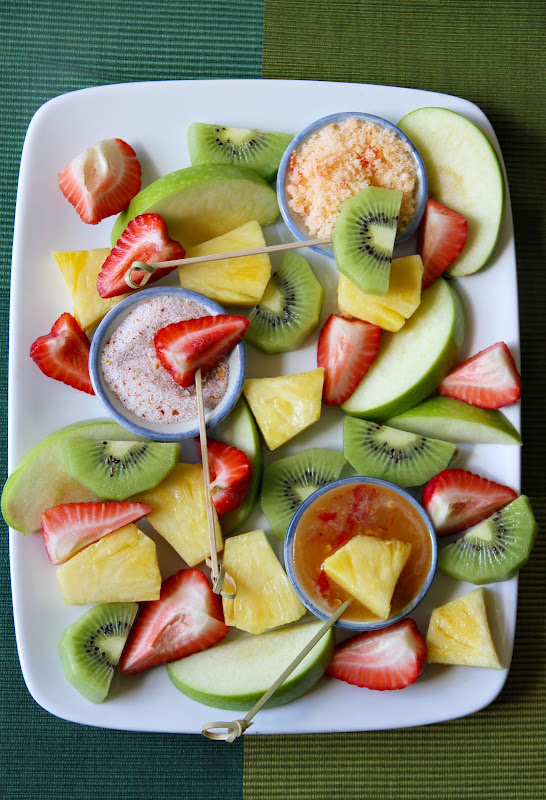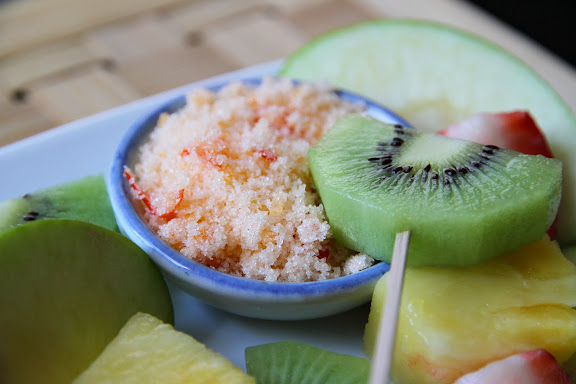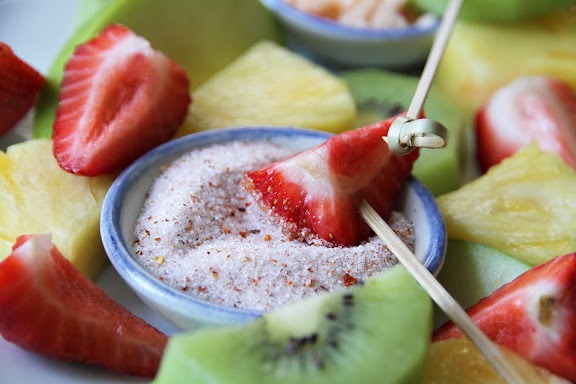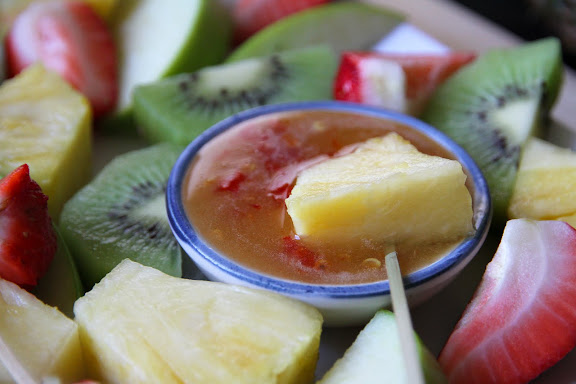
Quite a few readers have written me regarding Thai-style fruit dips saying how they wish there wasn’t any dried fish or fish sauce involved. Actually, the way the comments were worded is a little more interesting, a weird cross between disbelief and curiosity with a tiny, tiny tinge of disgust. I don’t blame them; I know how that feels. When I was invited to my first American thanksgiving dinner, I swallowed hard — and not in a good way — when I saw roasted turkey with gravy sitting between a pile of candied yams with broiled marshmallow topping and a quivering blob of fruit jelly called, “cranberry sauce.” I, of course, grew more accustomed to that combination and even came to like it. But, admittedly, the first encounter was pretty rough.
Our view regarding what should and shouldn’t be is all conditioned by culture. Tart green mangoes and a sticky dip containing fish sauce, palm sugar, and dried shrimp together are to most Thai people what apple pie and vanilla ice cream are to most Americans. In other words, fish and fruits work for us.
But if you don’t like it, there’s absolutely nothing wrong with that. Besides, there are other Thai-style fruit dips that don’t have fish products in them. Please allow me to introduce to you the most common three that go very well with tart fruits.
The first one, according to my experience, is by far the most common. Most fruit vendors will give you a little packet of this type of dip (prik kluea พริกเกลือ or prik kap kluea พริกกับเกลือ) with every purchase of fresh, prepared fruits. A more elaborate and costly dip like nampla wan (น้ำปลาหวาน) is usually not given for free, but fruit vendors tend to be more generous with this one.

It’s made out of three ingredients: granulated sugar, salt, and fresh (almost always) red chilies. The chilies are pounded into a fine paste and blended with sugar and salt. The end result is this sweet-salty dip spiced and tinted by the pounded chilies.
To make about half a cup, pound one or two (depending on your heat tolerance) red bird’s eye chilies in a mortar (you can also chop them up very finely), then add in 1/2 cup sugar and 2 teaspoons of salt, and blend well.

The second one is another type of prik (kap) kleua which is almost as common as the first one. It’s made the same way with the same ingredients in the same ratio. Simply replace fresh chilies with maybe a teaspoon or two of dried red pepper flakes (ground up into a finer powder). I actually prefer this type of dip, because I find that the smokiness of dried red pepper flakes works very well with fresh fruits.
Try serving this dip with jicama, peeled and cut into sticks. I could snack on that all day.

Then we have another one which is a simple palm sugar-based dip (which many people confuse with nampla wan). I don’t even know if it has an official name (does anyone know?). This type of dip is the least common of the three, and, from my experience, you’re most likely to see it at a guava (farang ฝรั่ง) stand. This could be because, being made of palm sugar, it’s more costly. Some fruit stands don’t even give this type of dip to you for free.
Most of the time, fish sauce serves as the source of salinity in this sticky dip. However, unlike nampla wan which must contain nampla (fish sauce) by definition, this one allows the fish sauce-averse to get away with using salt.
To make about a cup of this type of dip, put 180 grams (about a cup) of palm sugar (this type) with about 1/4 cup of plain water in a small pot and bring the mixture to a gentle boil over low heat. Be patient, and don’t use high heat. You just want to melt the palm sugar gently, not to caramelize it. Once the palm sugar is melted, add about 2 teaspoons of salt (more or less to taste) and one or two fresh red bird’s eye chilies which have been chopped finely or pounded into a fine paste in a mortar. Take the pot off the heat and let the dip cool. It will thicken up considerably, so be prepared to thin it out with a bit of water, if necessary. You want this dip to have the consistency of honey.







29 Responses to Fruit Dips, Thai Style